sensor TOYOTA BZ4X 2022 (in English) Workshop Manual
[x] Cancel search | Manufacturer: TOYOTA, Model Year: 2022, Model line: BZ4X, Model: TOYOTA BZ4X 2022Pages: 674, PDF Size: 120.02 MB
Page 329 of 674
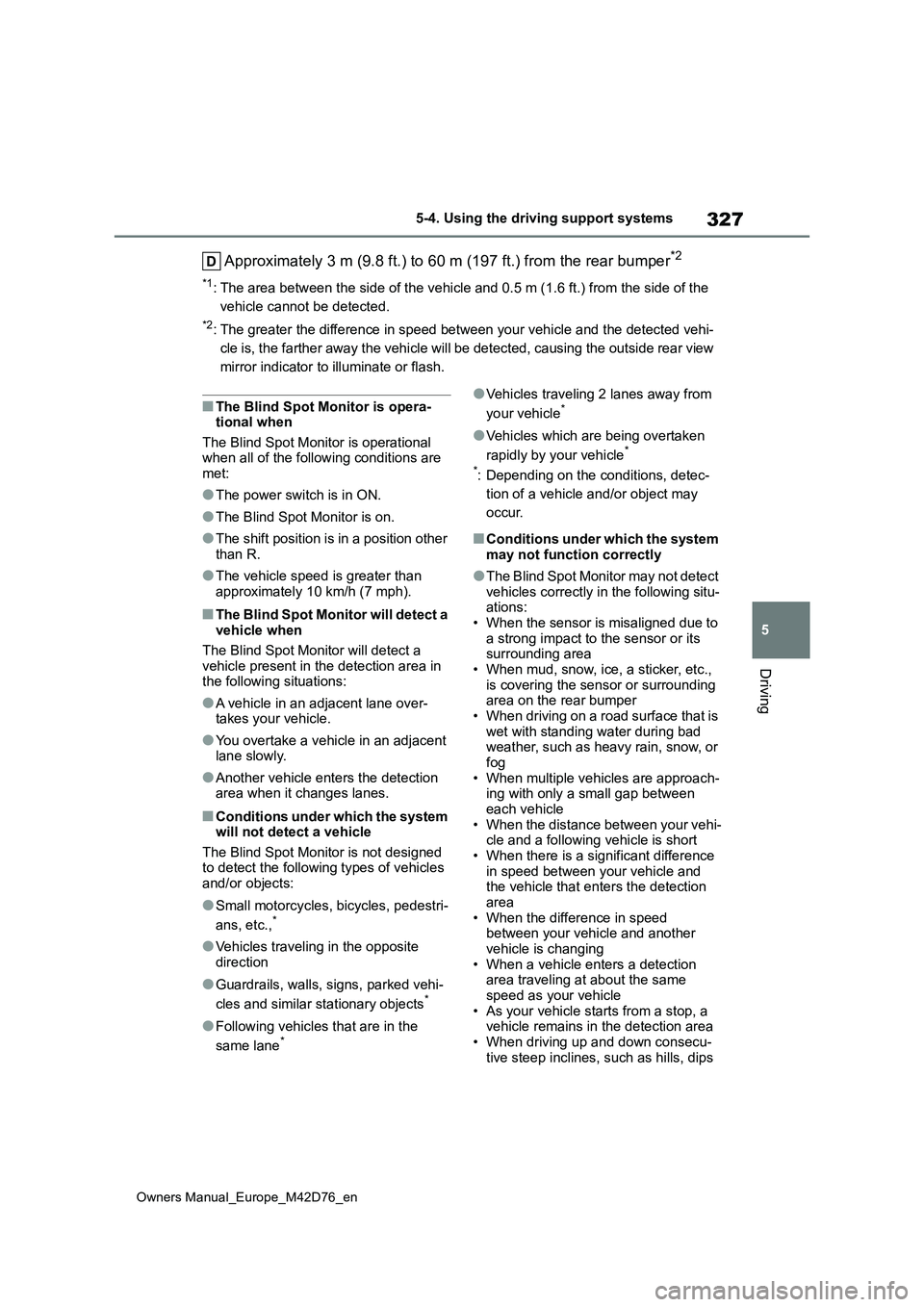
327
5
Owners Manual_Europe_M42D76_en
5-4. Using the driving support systems
Driving
Approximately 3 m (9.8 ft.) to 60 m (197 ft.) from the rear bumper*2
*1: The area between the side of the vehicle and 0.5 m (1.6 ft.) from the side of the
vehicle cannot be detected.
*2: The greater the difference in speed between your vehicle and t he detected vehi-
cle is, the farther away the vehicle will be detected, causing the outside rear view
mirror indicator to illuminate or flash.
■The Blind Spot Monitor is opera- tional when
The Blind Spot Monitor is operational when all of the following conditions are met:
●The power switch is in ON.
●The Blind Spot Monitor is on.
●The shift position is in a position other
than R.
●The vehicle speed is greater than
approximately 10 km/h (7 mph).
■The Blind Spot Monitor will detect a vehicle when
The Blind Spot Monitor will detect a
vehicle present in the detection area in the following situations:
●A vehicle in an adjacent lane over-takes your vehicle.
●You overtake a vehicle in an adjacent lane slowly.
●Another vehicle enters the detection area when it changes lanes.
■Conditions under which the system will not detect a vehicle
The Blind Spot Monitor is not designed to detect the following types of vehicles and/or objects:
●Small motorcycles, bicycles, pedestri-
ans, etc.,*
●Vehicles traveling in the opposite direction
●Guardrails, walls, signs, parked vehi-
cles and similar stationary objects*
●Following vehicles that are in the
same lane*
●Vehicles traveling 2 lanes away from
your vehicle*
●Vehicles which are being overtaken
rapidly by your vehicle*
*: Depending on the conditions, detec-
tion of a vehicle and/or object may
occur.
■Conditions under which the system may not function correctly
●The Blind Spot Monitor may not detect vehicles correctly in the following situ-ations:
• When the sensor is misaligned due to a strong impact to the sensor or its surrounding area
• When mud, snow, ice, a sticker, etc., is covering the sensor or surrounding area on the rear bumper
• When driving on a road surface that is wet with standing water during bad weather, such as heavy rain, snow, or
fog • When multiple vehicles are approach-ing with only a small gap between
each vehicle • When the distance between your vehi-cle and a following vehicle is short
• When there is a significant difference in speed between your vehicle and the vehicle that enters the detection
area • When the difference in speed between your vehicle and another
vehicle is changing • When a vehicle enters a detection area traveling at about the same
speed as your vehicle • As your vehicle starts from a stop, a vehicle remains in the detection area
• When driving up and down consecu- tive steep inclines, such as hills, dips
Page 330 of 674
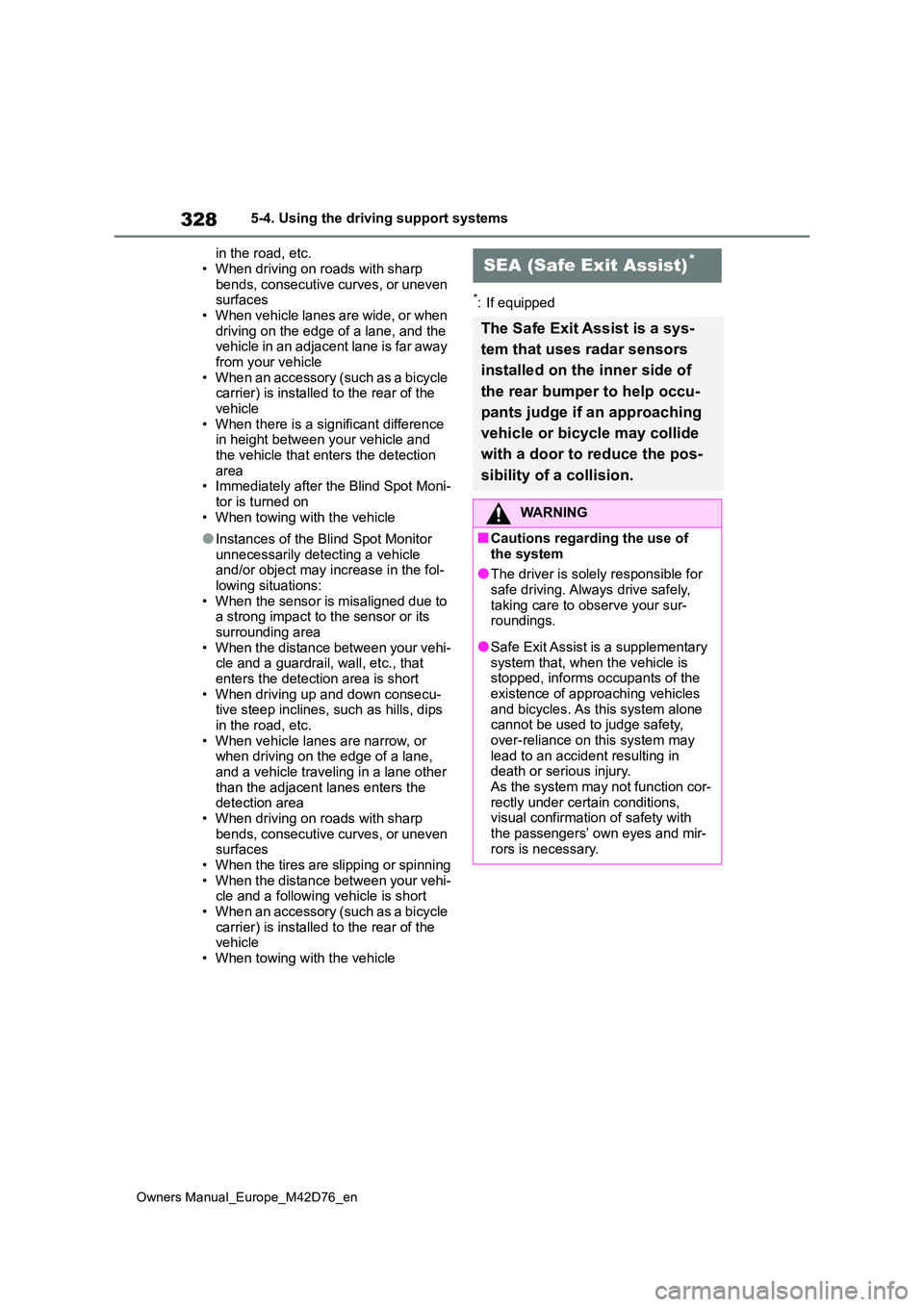
328
Owners Manual_Europe_M42D76_en
5-4. Using the driving support systems
in the road, etc.
• When driving on roads with sharp bends, consecutive curves, or uneven surfaces
• When vehicle lanes are wide, or when driving on the edge of a lane, and the vehicle in an adjacent lane is far away
from your vehicle • When an accessory (such as a bicycle carrier) is installed to the rear of the
vehicle • When there is a significant difference in height between your vehicle and
the vehicle that enters the detection area• Immediately after the Blind Spot Moni-
tor is turned on • When towing with the vehicle
●Instances of the Blind Spot Monitor unnecessarily detecting a vehicle and/or object may increase in the fol-
lowing situations: • When the sensor is misaligned due to a strong impact to the sensor or its
surrounding area • When the distance between your vehi-cle and a guardrail, wall, etc., that
enters the detection area is short • When driving up and down consecu-tive steep inclines, such as hills, dips
in the road, etc. • When vehicle lanes are narrow, or when driving on the edge of a lane,
and a vehicle traveling in a lane other than the adjacent lanes enters the detection area
• When driving on roads with sharp bends, consecutive curves, or uneven surfaces
• When the tires are slipping or spinning • When the distance between your vehi-cle and a following vehicle is short
• When an accessory (such as a bicycle carrier) is installed to the rear of the vehicle
• When towing with the vehicle
*: If equipped
SEA (Safe Exit Assist)*
The Safe Exit Assist is a sys-
tem that uses radar sensors
installed on the inner side of
the rear bumper to help occu-
pants judge if an approaching
vehicle or bicycle may collide
with a door to reduce the pos-
sibility of a collision.
WARNING
■Cautions regarding the use of
the system
●The driver is solely responsible for safe driving. Always drive safely,
taking care to observe your sur- roundings.
●Safe Exit Assist is a supplementary system that, when the vehicle is stopped, informs occupants of the
existence of approaching vehicles and bicycles. As this system alone cannot be used to judge safety,
over-reliance on this system may lead to an accident resulting in death or serious injury.
As the system may not function cor- rectly under certain conditions, visual confirmation of safety with
the passengers’ own eyes and mir- rors is necessary.
Page 331 of 674
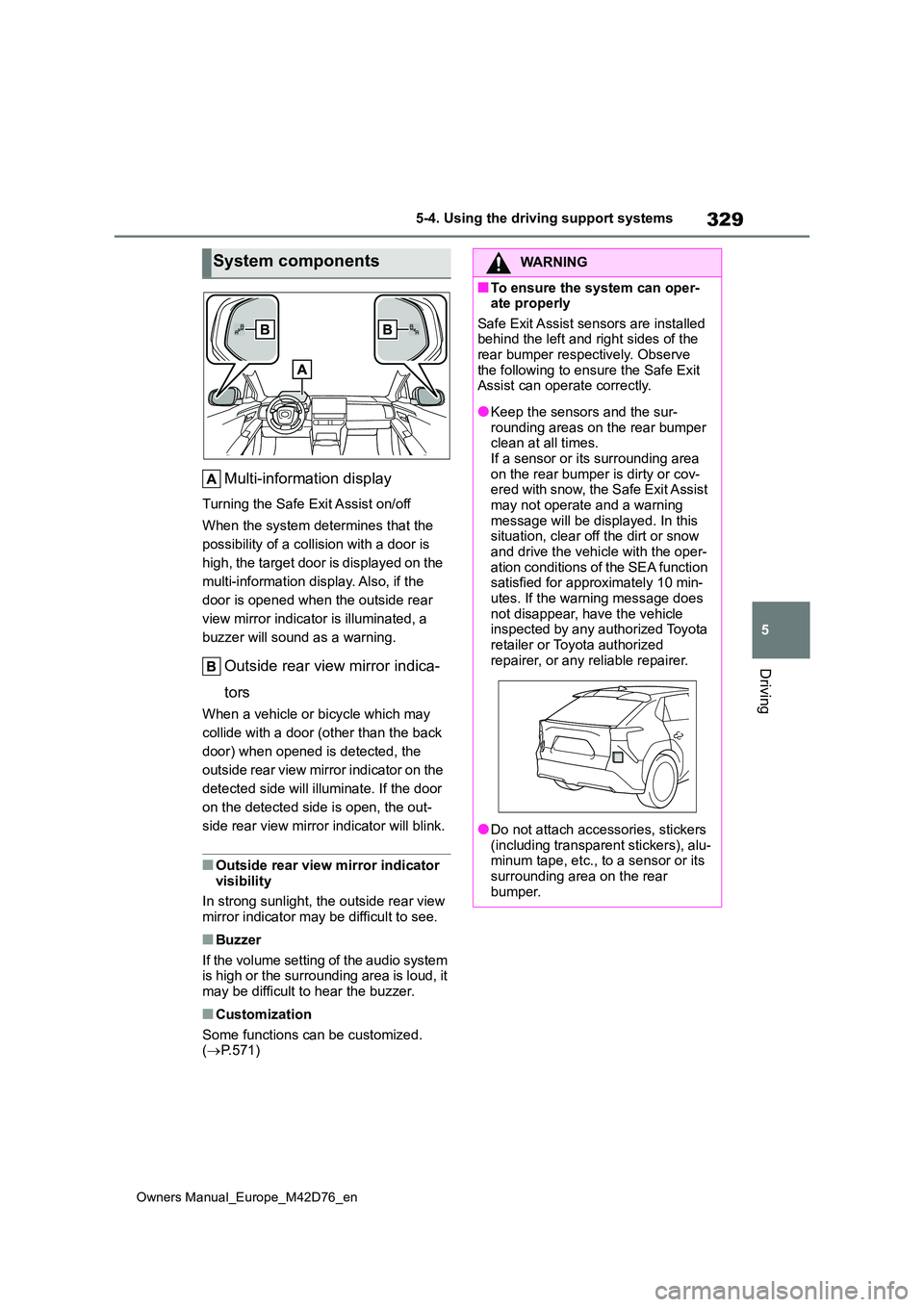
329
5
Owners Manual_Europe_M42D76_en
5-4. Using the driving support systems
Driving
Multi-information display
Turning the Safe Exit Assist on/off
When the system determines that the
possibility of a collision with a door is
high, the target door is displayed on the
multi-information display. Also, if the
door is opened when the outside rear
view mirror indicator is illuminated, a
buzzer will sound as a warning.
Outside rear view mirror indica-
tors
When a vehicle or bicycle which may
collide with a door (other than the back
door) when opened is detected, the
outside rear view mirror indicator on the
detected side will illuminate. If the door
on the detected side is open, the out-
side rear view mirror indicator will blink.
■Outside rear view mirror indicator
visibility
In strong sunlight, the outside rear view mirror indicator may be difficult to see.
■Buzzer
If the volume setting of the audio system is high or the surrounding area is loud, it may be difficult to hear the buzzer.
■Customization
Some functions can be customized. ( P.571)
System componentsWARNING
■To ensure the system can oper- ate properly
Safe Exit Assist sensors are installed behind the left and right sides of the rear bumper respectively. Observe
the following to ensure the Safe Exit Assist can operate correctly.
●Keep the sensors and the sur-rounding areas on the rear bumper clean at all times.
If a sensor or its surrounding area on the rear bumper is dirty or cov-ered with snow, the Safe Exit Assist
may not operate and a warning message will be displayed. In this situation, clear off the dirt or snow
and drive the vehicle with the oper- ation conditions of the SEA function satisfied for approximately 10 min-
utes. If the warning message does not disappear, have the vehicle inspected by any authorized Toyota
retailer or Toyota authorized repairer, or any reliable repairer.
●Do not attach accessories, stickers (including transparent stickers), alu-minum tape, etc., to a sensor or its
surrounding area on the rear bumper.
Page 332 of 674
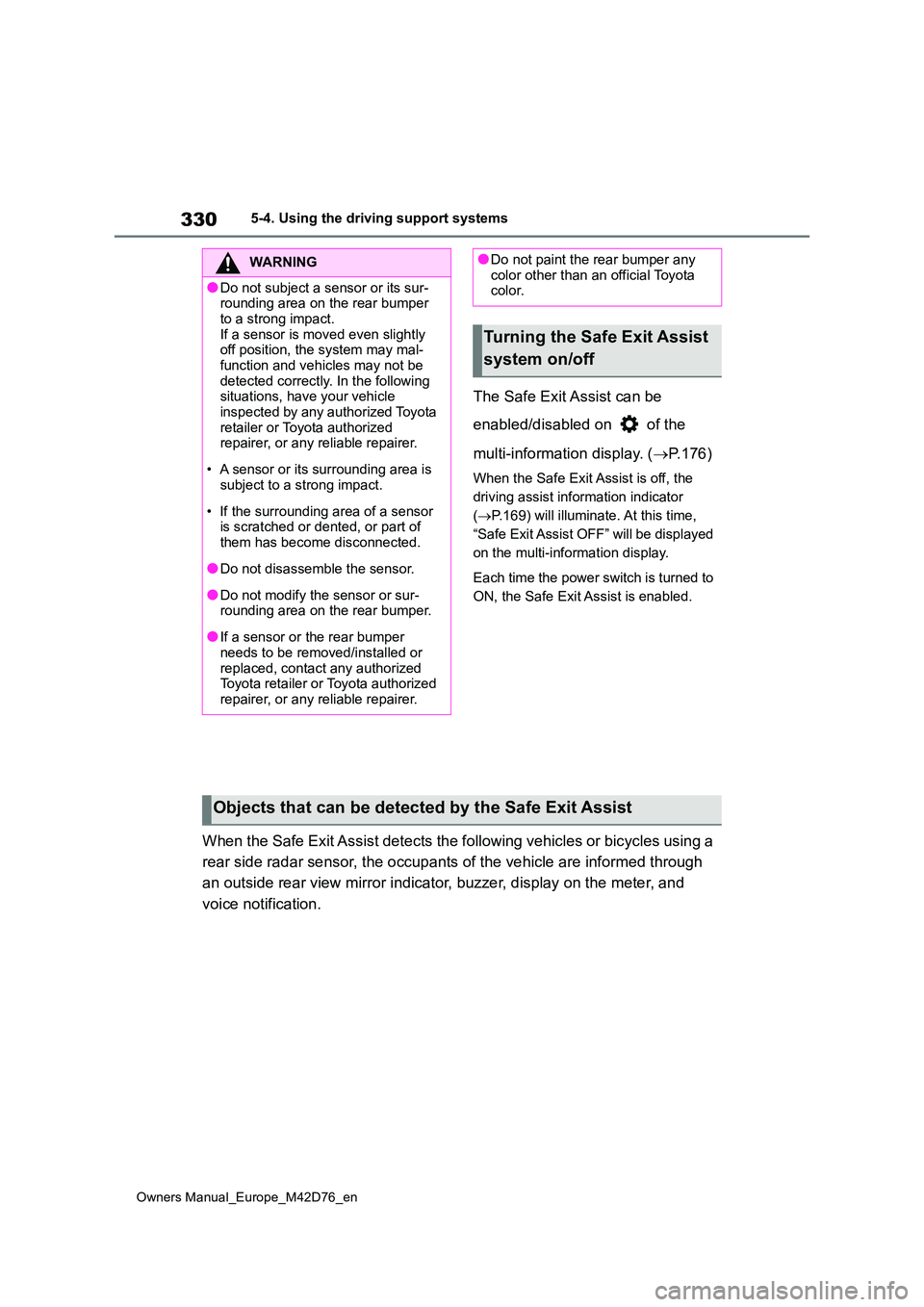
330
Owners Manual_Europe_M42D76_en
5-4. Using the driving support systems
The Safe Exit Assist can be
enabled/disabled on of the
multi-information display. ( P.176)
When the Safe Exit Assist is off, the
driving assist information indicator
( P.169) will illuminate. At this time,
“Safe Exit Assist OFF” will be displayed
on the multi-information display.
Each time the power switch is turned to
ON, the Safe Exit Assist is enabled.
When the Safe Exit Assist detects the following vehicles or bic ycles using a
rear side radar sensor, the occupants of the vehicle are inform ed through
an outside rear view mirror indicator, buzzer, display on the m eter, and
voice notification.
WARNING
●Do not subject a sensor or its sur- rounding area on the rear bumper
to a strong impact. If a sensor is moved even slightly off position, the system may mal-
function and vehicles may not be detected correctly. In the following situations, have your vehicle
inspected by any authorized Toyota retailer or Toyota authorized repairer, or any reliable repairer.
• A sensor or its surrounding area is subject to a strong impact.
• If the surrounding area of a sensor is scratched or dented, or part of
them has become disconnected.
●Do not disassemble the sensor.
●Do not modify the sensor or sur- rounding area on the rear bumper.
●If a sensor or the rear bumper needs to be removed/installed or
replaced, contact any authorized Toyota retailer or Toyota authorized repairer, or any reliable repairer.
●Do not paint the rear bumper any color other than an official Toyota color.
Turning the Safe Exit Assist
system on/off
Objects that can be detected by the Safe Exit Assist
Page 334 of 674
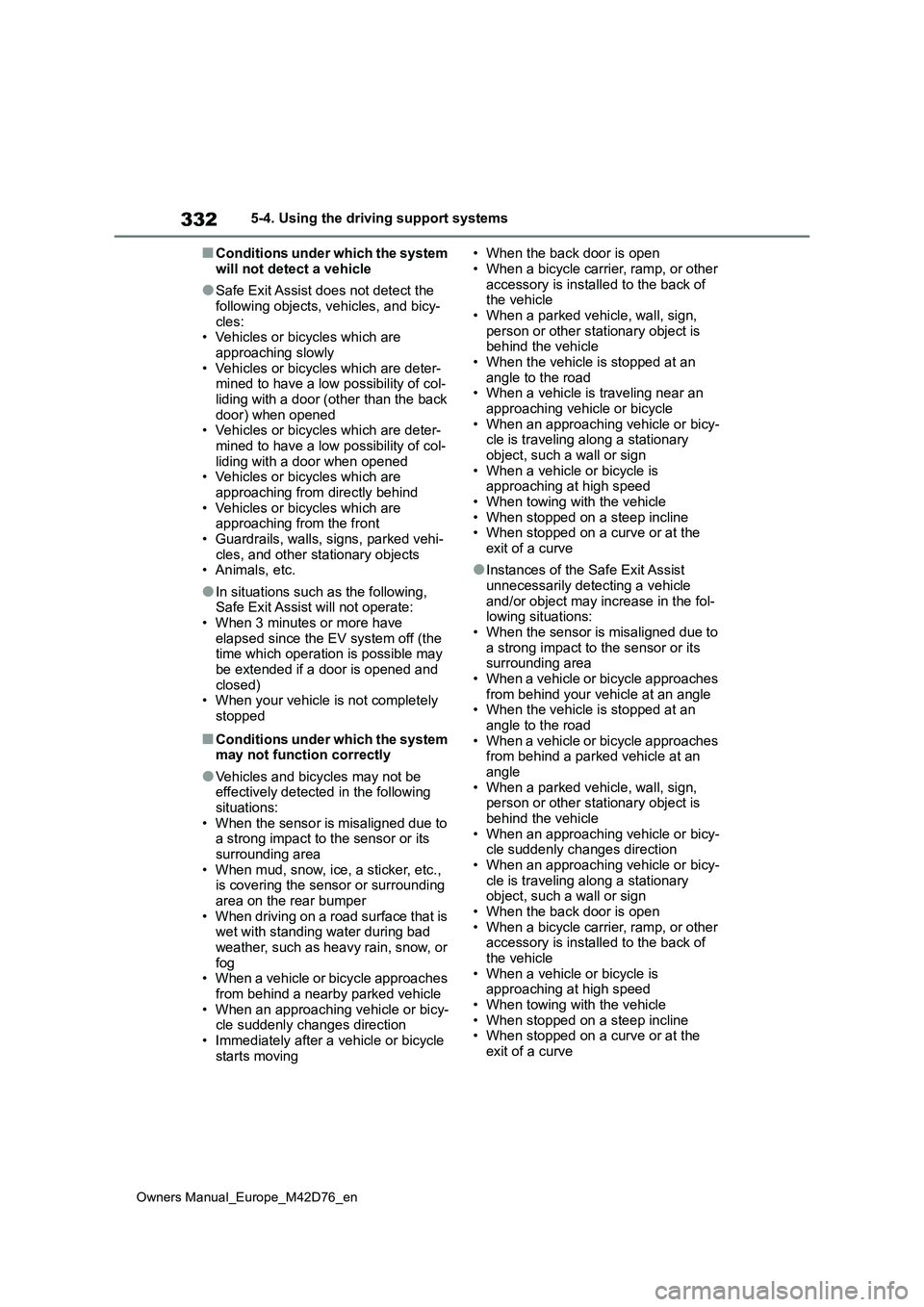
332
Owners Manual_Europe_M42D76_en
5-4. Using the driving support systems
■Conditions under which the system
will not detect a vehicle
●Safe Exit Assist does not detect the
following objects, vehicles, and bicy- cles:• Vehicles or bicycles which are
approaching slowly • Vehicles or bicycles which are deter-mined to have a low possibility of col-
liding with a door (other than the back door) when opened• Vehicles or bicycles which are deter-
mined to have a low possibility of col- liding with a door when opened• Vehicles or bicycles which are
approaching from directly behind • Vehicles or bicycles which are approaching from the front
• Guardrails, walls, signs, parked vehi- cles, and other stationary objects• Animals, etc.
●In situations such as the following, Safe Exit Assist will not operate:
• When 3 minutes or more have elapsed since the EV system off (the time which operation is possible may
be extended if a door is opened and closed)• When your vehicle is not completely
stopped
■Conditions under which the system may not function correctly
●Vehicles and bicycles may not be effectively detected in the following situations:
• When the sensor is misaligned due to a strong impact to the sensor or its surrounding area
• When mud, snow, ice, a sticker, etc., is covering the sensor or surrounding area on the rear bumper
• When driving on a road surface that is wet with standing water during bad weather, such as heavy rain, snow, or
fog • When a vehicle or bicycle approaches from behind a nearby parked vehicle
• When an approaching vehicle or bicy- cle suddenly changes direction• Immediately after a vehicle or bicycle
starts moving
• When the back door is open
• When a bicycle carrier, ramp, or other accessory is installed to the back of the vehicle
• When a parked vehicle, wall, sign, person or other stationary object is behind the vehicle
• When the vehicle is stopped at an angle to the road• When a vehicle is traveling near an
approaching vehicle or bicycle • When an approaching vehicle or bicy-cle is traveling along a stationary
object, such a wall or sign • When a vehicle or bicycle is approaching at high speed
• When towing with the vehicle • When stopped on a steep incline• When stopped on a curve or at the
exit of a curve
●Instances of the Safe Exit Assist
unnecessarily detecting a vehicle and/or object may increase in the fol-lowing situations:
• When the sensor is misaligned due to a strong impact to the sensor or its surrounding area
• When a vehicle or bicycle approaches from behind your vehicle at an angle• When the vehicle is stopped at an
angle to the road • When a vehicle or bicycle approaches from behind a parked vehicle at an
angle • When a parked vehicle, wall, sign, person or other stationary object is
behind the vehicle • When an approaching vehicle or bicy-cle suddenly changes direction
• When an approaching vehicle or bicy- cle is traveling along a stationary object, such a wall or sign
• When the back door is open • When a bicycle carrier, ramp, or other accessory is installed to the back of
the vehicle • When a vehicle or bicycle is approaching at high speed
• When towing with the vehicle • When stopped on a steep incline• When stopped on a curve or at the
exit of a curve
Page 335 of 674
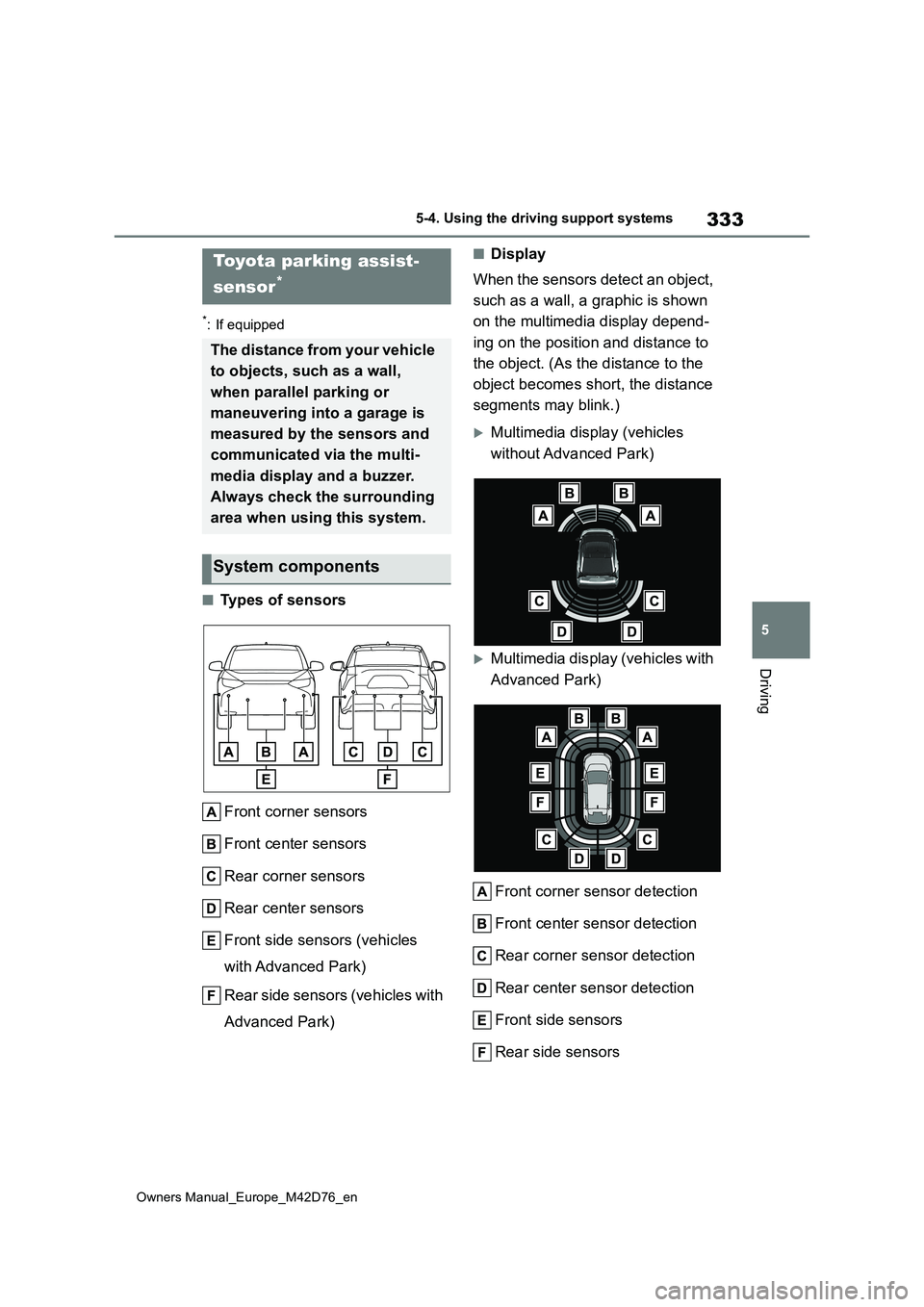
333
5
Owners Manual_Europe_M42D76_en
5-4. Using the driving support systems
Driving
*: If equipped
■Types of sensors
Front corner sensors
Front center sensors
Rear corner sensors
Rear center sensors
Front side sensors (vehicles
with Advanced Park)
Rear side sensors (vehicles with
Advanced Park)
■Display
When the sensors detect an object,
such as a wall, a graphic is shown
on the multimedia display depend-
ing on the position and distance to
the object. (As the distance to the
object becomes short, the distance
segments may blink.)
Multimedia display (vehicles
without Advanced Park)
Multimedia display (vehicles with
Advanced Park)
Front corner sensor detection
Front center sensor detection
Rear corner sensor detection
Rear center sensor detection
Front side sensors
Rear side sensors
Toyota parking assist-
sensor*
The distance from your vehicle
to objects, such as a wall,
when parallel parking or
maneuvering into a garage is
measured by the sensors and
communicated via the multi-
media display and a buzzer.
Always check the surrounding
area when using this system.
System components
Page 336 of 674
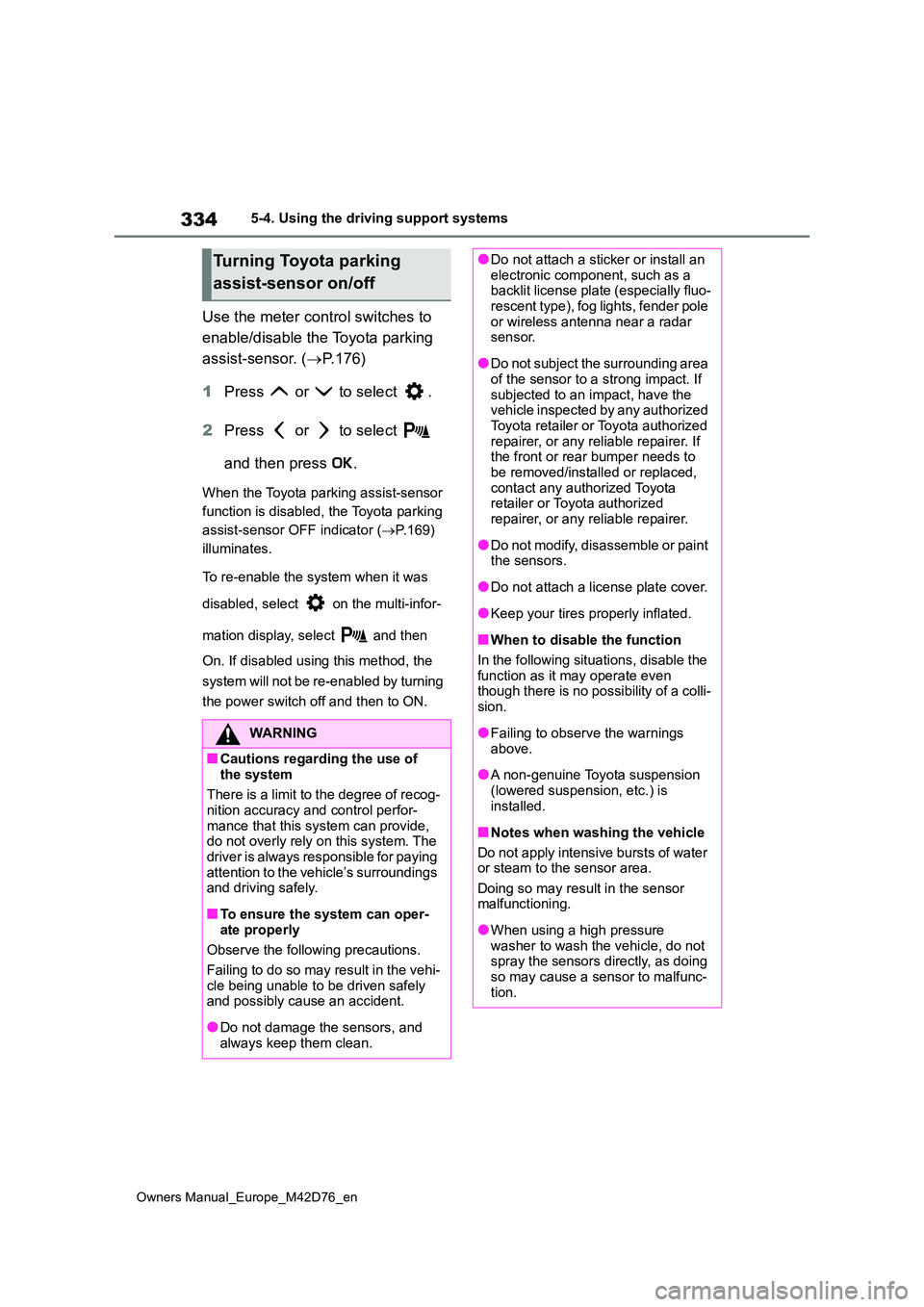
334
Owners Manual_Europe_M42D76_en
5-4. Using the driving support systems
Use the meter control switches to
enable/disable the Toyota parking
assist-sensor. ( P. 1 7 6 )
1 Press or to select .
2 Press or to select
and then press .
When the Toyota parking assist-sensor
function is disabled, the Toyota parking
assist-sensor OFF indicator ( P.169)
illuminates.
To re-enable the system when it was
disabled, select on the multi-infor-
mation display, select and then
On. If disabled using this method, the
system will not be re-enabled by turning
the power switch off and then to ON.
Turning Toyota parking
assist-sensor on/off
WARNING
■Cautions regarding the use of
the system
There is a limit to the degree of recog- nition accuracy and control perfor-
mance that this system can provide, do not overly rely on this system. The driver is always responsible for paying
attention to the vehicle’s surroundings and driving safely.
■To ensure the system can oper-ate properly
Observe the following precautions.
Failing to do so may result in the vehi- cle being unable to be driven safely and possibly cause an accident.
●Do not damage the sensors, and always keep them clean.
●Do not attach a sticker or install an electronic component, such as a backlit license plate (especially fluo-
rescent type), fog lights, fender pole or wireless antenna near a radar sensor.
●Do not subject the surrounding area of the sensor to a strong impact. If
subjected to an impact, have the vehicle inspected by any authorized Toyota retailer or Toyota authorized
repairer, or any reliable repairer. If the front or rear bumper needs to be removed/installed or replaced,
contact any authorized Toyota retailer or Toyota authorized repairer, or any reliable repairer.
●Do n ot m od i fy, d is a sse mb l e o r p ai n t the sensors.
●Do not attach a license plate cover.
●Keep your tires properly inflated.
■When to disable the function
In the following situations, disable the function as it may operate even though there is no possibility of a colli-
sion.
●Failing to observe the warnings
above.
●A non-genuine Toyota suspension
(lowered suspension, etc.) is installed.
■Notes when washing the vehicle
Do not apply intensive bursts of water or steam to the sensor area.
Doing so may result in the sensor malfunctioning.
●When using a high pressure washer to wash the vehicle, do not spray the sensors directly, as doing
so may cause a sensor to malfunc- tion.
Page 337 of 674
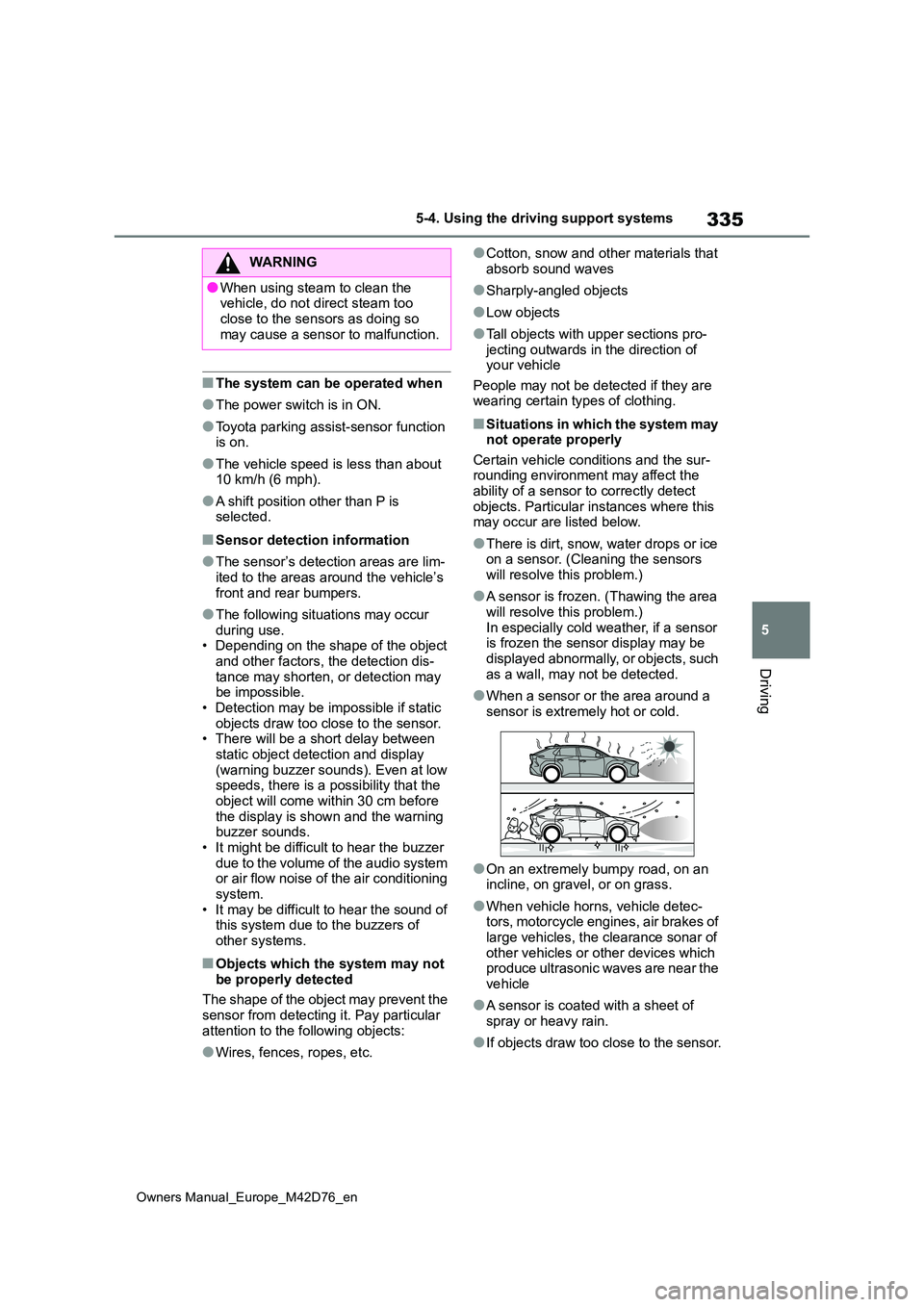
335
5
Owners Manual_Europe_M42D76_en
5-4. Using the driving support systems
Driving
■The system can be operated when
●The power switch is in ON.
●Toyota parking assist-sensor function is on.
●The vehicle speed is less than about 10 km/h (6 mph).
●A shift position other than P is selected.
■Sensor detection information
●The sensor’s detection areas are lim-ited to the areas around the vehicle’s
front and rear bumpers.
●The following situations may occur
during use. • Depending on the shape of the object and other factors, the detection dis-
tance may shorten, or detection may be impossible.• Detection may be impossible if static
objects draw too close to the sensor. • There will be a short delay between static object detection and display
(warning buzzer sounds). Even at low speeds, there is a possibility that the object will come within 30 cm before
the display is shown and the warning buzzer sounds.• It might be difficult to hear the buzzer
due to the volume of the audio system or air flow noise of the air conditioning system.
• It may be difficult to hear the sound of this system due to the buzzers of other systems.
■Objects which the system may not
be properly detected
The shape of the object may prevent the sensor from detecting it. Pay particular
attention to the following objects:
●Wires, fences, ropes, etc.
●Cotton, snow and other materials that
absorb sound waves
●Sharply-angled objects
●Low objects
●Tall objects with upper sections pro- jecting outwards in the direction of your vehicle
People may not be detected if they are wearing certain types of clothing.
■Situations in which the system may not operate properly
Certain vehicle conditions and the sur- rounding environment may affect the ability of a sensor to correctly detect
objects. Particular instances where this may occur are listed below.
●There is dirt, snow, water drops or ice on a sensor. (Cleaning the sensors will resolve this problem.)
●A sensor is frozen. (Thawing the area will resolve this problem.)
In especially cold weather, if a sensor is frozen the sensor display may be displayed abnormally, or objects, such
as a wall, may not be detected.
●When a sensor or the area around a
sensor is extremely hot or cold.
●On an extremely bumpy road, on an incline, on gravel, or on grass.
●When vehicle horns, vehicle detec-tors, motorcycle engines, air brakes of large vehicles, the clearance sonar of
other vehicles or other devices which produce ultrasonic waves are near the vehicle
●A sensor is coated with a sheet of spray or heavy rain.
●If objects draw too close to the sensor.
WARNING
●When using steam to clean the vehicle, do not direct steam too
close to the sensors as doing so may cause a sensor to malfunction.
Page 338 of 674
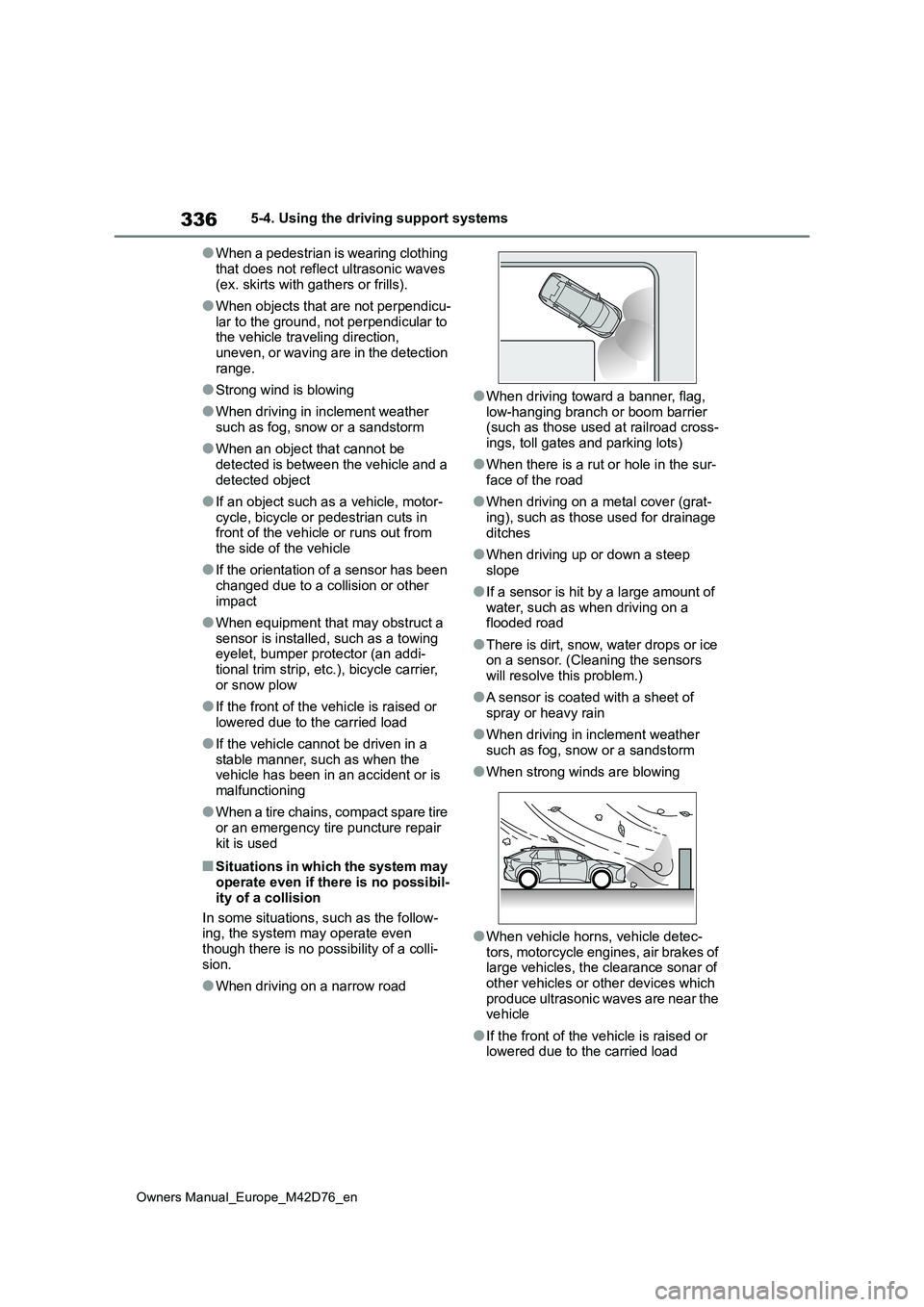
336
Owners Manual_Europe_M42D76_en
5-4. Using the driving support systems
●When a pedestrian is wearing clothing
that does not reflect ultrasonic waves (ex. skirts with gathers or frills).
●When objects that are not perpendicu-lar to the ground, not perpendicular to the vehicle traveling direction,
uneven, or waving are in the detection range.
●Strong wind is blowing
●When driving in inclement weather
such as fog, snow or a sandstorm
●When an object that cannot be
detected is between the vehicle and a detected object
●If an object such as a vehicle, motor-cycle, bicycle or pedestrian cuts in front of the vehicle or runs out from
the side of the vehicle
●If the orientation of a sensor has been
changed due to a collision or other impact
●When equipment that may obstruct a sensor is installed, such as a towing eyelet, bumper protector (an addi-
tional trim strip, etc.), bicycle carrier, or snow plow
●If the front of the vehicle is raised or lowered due to the carried load
●If the vehicle cannot be driven in a stable manner, such as when the vehicle has been in an accident or is
malfunctioning
●When a tire chains, compact spare tire
or an emergency tire puncture repair kit is used
■Situations in which the system may operate even if there is no possibil-
ity of a collision
In some situations, such as the follow- ing, the system may operate even
though there is no possibility of a colli- sion.
●When driving on a narrow road
●When driving toward a banner, flag,
low-hanging branch or boom barrier (such as those used at railroad cross-ings, toll gates and parking lots)
●When there is a rut or hole in the sur-face of the road
●When driving on a metal cover (grat-ing), such as those used for drainage
ditches
●When driving up or down a steep
slope
●If a sensor is hit by a large amount of
water, such as when driving on a flooded road
●There is dirt, snow, water drops or ice on a sensor. (Cleaning the sensors will resolve this problem.)
●A sensor is coated with a sheet of spray or heavy rain
●When driving in inclement weather such as fog, snow or a sandstorm
●When strong winds are blowing
●When vehicle horns, vehicle detec-tors, motorcycle engines, air brakes of large vehicles, the clearance sonar of
other vehicles or other devices which produce ultrasonic waves are near the vehicle
●If the front of the vehicle is raised or lowered due to the carried load
Page 339 of 674
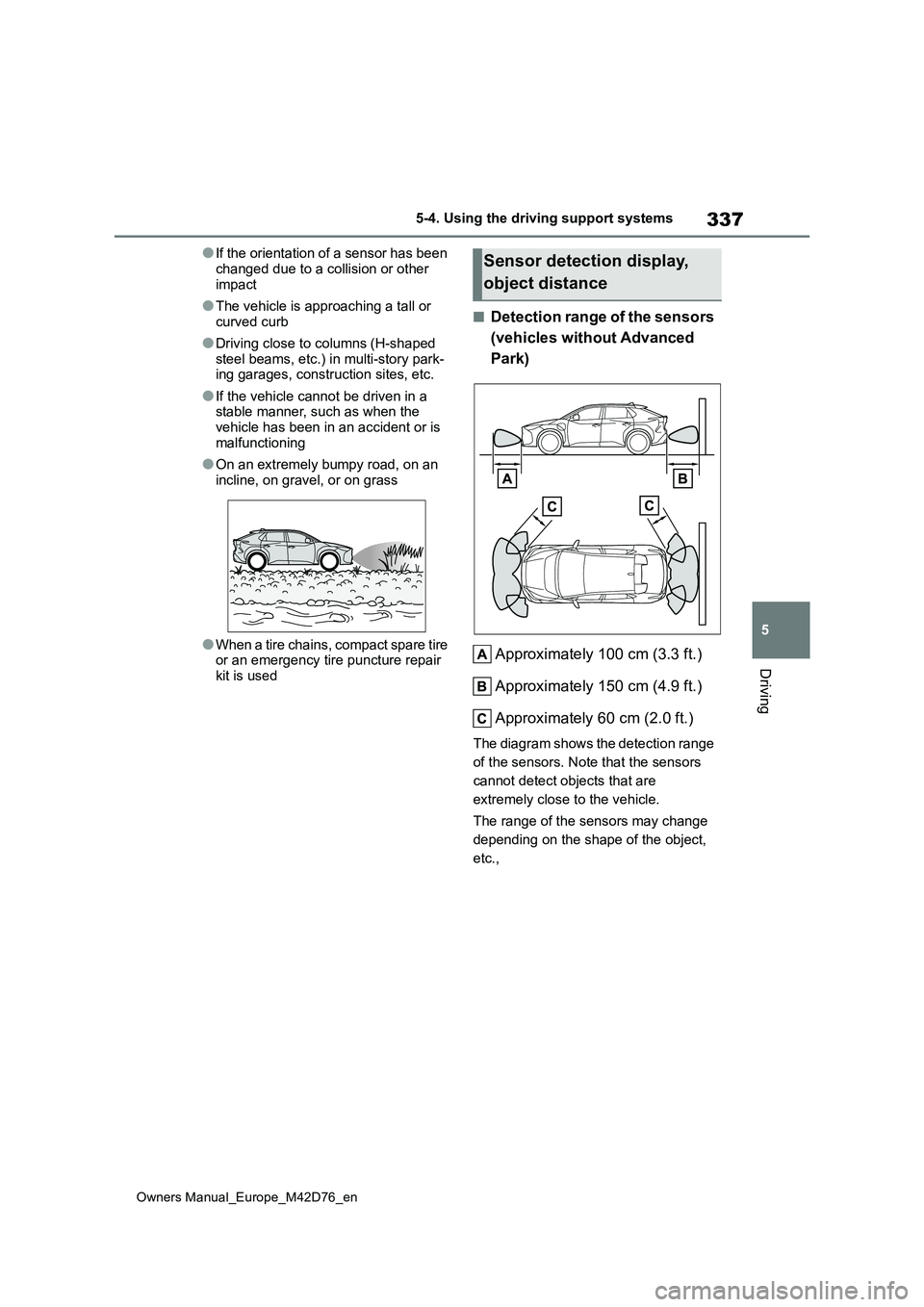
337
5
Owners Manual_Europe_M42D76_en
5-4. Using the driving support systems
Driving
●If the orientation of a sensor has been
changed due to a collision or other impact
●The vehicle is approaching a tall or curved curb
●Driving close to columns (H-shaped steel beams, etc.) in multi-story park-ing garages, construction sites, etc.
●If the vehicle cannot be driven in a stable manner, such as when the
vehicle has been in an accident or is malfunctioning
●On an extremely bumpy road, on an incline, on gravel, or on grass
●When a tire chains, compact spare tire or an emergency tire puncture repair kit is used
■Detection range of the sensors
(vehicles without Advanced
Park)
Approximately 100 cm (3.3 ft.)
Approximately 150 cm (4.9 ft.)
Approximately 60 cm (2.0 ft.)
The diagram shows the detection range
of the sensors. Note that the sensors
cannot detect objects that are
extremely close to the vehicle.
The range of the sensors may change
depending on the shape of the object,
etc.,
Sensor detection display,
object distance